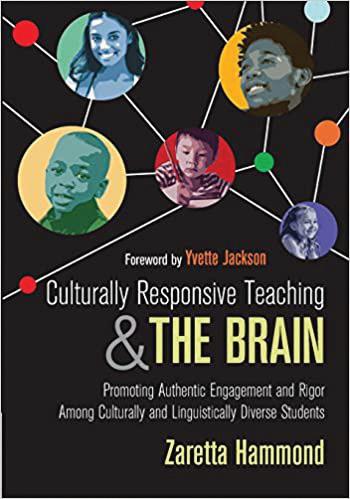
5 minute read
Book Review: Culturally Responsive Teaching and The Brain Promoting Authentic Engagement and Rigor Among Culturally and Linguistically Diverse Students
Montessori Now
BOOK REVIEW by Christine Lowry Culturally Responsive Teaching and The Brain Promoting Authentic Engagement and Rigor Among Culturally and Linguistically Diverse Students by Zaretta Hammond
Culturally Responsive Teaching and The
Brain, written by Zaretta Hammond, examines the philosophy and implementation of culturally responsive teaching in the context of current research and knowledge of neuropsychology and its impact on student behavior and response. The book seeks to connect current brain research and culturally responsive teaching with the question “what is needed to activate that wiring for optimal connectivity for students of color?” Understanding the classroom practices that can serve as triggers for engagement of various regions of the brain can help educators adapt their practices in a culturally relevant way that supports students of color.
The book explores this premise in three parts. Part One: Building Awareness and Knowledge, Part Two: Building Learning Partnerships, and Part Three: Building Intellective Capacity. Each section brings together the information of neuropsychology with a study of cultures with the goal of educating teachers to become culturally sensitive and responsive to their students. With practical, concrete examples of teaching strategies, and self-reflections, Ms. Hammond leads the reader through the process of developing the skills and understanding needed to offer a culturally responsive classroom environment to all students.
As culturally responsive teaching is more a philosophy, or mindset, rather than a method,
Part One: Building Awareness and Knowledge
begins to explore the goal of guiding “dependent learners” to becoming students who are independent thinkers who are self-motivated and confident in their abilities. With the premise that educators can change the “habits of mind” of the dependent learner, Hammond explores the importance of relationship, creating a classroom that helps students reach their zone of proximal development with just the right challenges, and the tools that teachers can use to implement culturally responsive teaching. The Ready for Rigor Framework includes the components of Awareness, Learning Partnerships, Information Processing, and Community of Learners and Learning Environment. Educators must first understand the role that culture plays in learning and to understand the sociopolitical and economic
conditions that are the root of the inequities that contribute to the achievement gap for students in marginalized groups. Educators are encouraged to reflect on their own biases, values and beliefs by looking at layers of culture from surface to those cultural archetypes that can lead to an understanding of one’s implicit bias. Increasing knowledge of the regions of the brain and the role each plays in one’s behavior becomes the backdrop for further understanding of those “triggers” that result in certain student behaviors that further reinforce their dependence as learners. Practical advice that teachers can use in the classroom to avoid these “triggers” leads to Part Two: Building Learner Partnerships.
Building partnerships based on affirmations, mutual respect, and validation enables students to develop trust and a sense of safety to take risks in their learning. Starting with rapport, or connection, and developing an alliance leads to the cognitive insights and higher order thinking skills of independent learners.
Ms. Hammond encourages educators to reflect, observe, and collect data on their behaviors and mindset that contributes to a positive alliance with each student. This alliance means becoming a student’s ally by agreeing on a goal, setting high expectations, acknowledging ability, and providing feedback that gives specific information about successes and next steps. With increased motivation and an “academic mindset,” the student begins to believe in his ability and understand that it is sociopolitical impacts, rather than personal ability, that are the cause of inequity.

Part Three: Building Intellective Capacity
provides many concrete teaching techniques to support students of color. Dr. Hammond discusses four components of learning as Ignite, capturing the student’s attention, Chunk, providing specific amounts of information in segments, Chew, giving opportunities to process that information in active ways, and Review, the projects to apply this new information and connect it to previous learning. The techniques shared are in the context of culturally responsive teaching and the brain science presented in parts one and two.
The final strategy for building intellective capacity is preparing a classroom environment for all students to feel a connection and sense of a community that is socially and intellectually safe. This includes examining the visual look of the classroom, the routines, the rituals, but beyond that ways to provide each student with meaningful learning in a community of peers.
Ms. Hammond reminds teachers that “embracing conscious incompetence” is an important aspect of growth and development. Being willing to reflect, change behavior, try new techniques takes time and effort. The goal of equity for all students is worth the struggle. This book provides a framework for thinking about and acting in a more culturally responsive manner. Developing the knowledge and understanding of the impact of culture on learning enriches our role as a teacher of children and adults. Valuing equity in education is a goal that, on the surface, is easily shared. The format of this book encourages a deeper look at that goal with knowledge, information, and specific tools and techniques for actual practice as a culturally sensitive and responsive educator.
Cultivating an attitude, a culturally responsive mindset, to view a school should be implemented in practice by leaders, and teachers in a way that is specific to their school culture. Forming an alliance with each other, with our students and with their families, begins with respect, rapport, and engagement that is specific to each culture.
As Montessori educators, we need to create classrooms and schools that support all marginalized groups. The concepts and ideas presented in this work can be a starting point as we begin to explore a supportive framework for all diverse learners- cultural, racial, ethnic, and those who learn in a unique way. As we develop classrooms of inclusion for all students we must become more aware of the impact of relationship, learning techniques, and the classroom community on every student in our classrooms.
Hammond, Zaretta. (2015). Culturally Responsive Teaching and the Brain. Thousand Oaks, CA: Corwin.
The MonTessori Leadership insTiTuTe
Montessori Leadership Courses Online

An excellent and convenient way to gain new leadership skills and understanding, no matter what your current level of experience and Montessori background happens to be. For more information visit www.montessori.org.
Customized Live / Online Staff Workshops / Professional Development
n
n
n
n
n
n
n
n Special focus short courses for Montessori guides Board leadership development Financial and strategic planning Montessori school consulting Personalized Montessori school leadership coaching Small cohort Montessori school leadership coaching Marketing, enrollment, family relationships, and retention Recruiting, hiring, and building a strong Montessori faculty team










